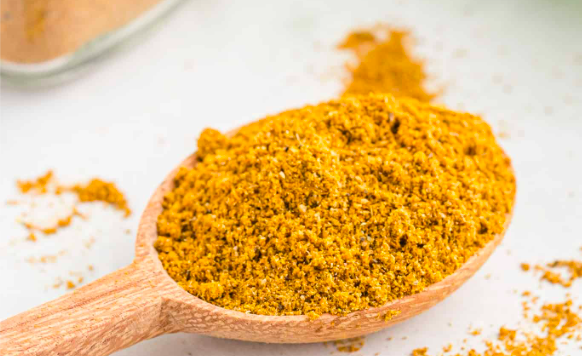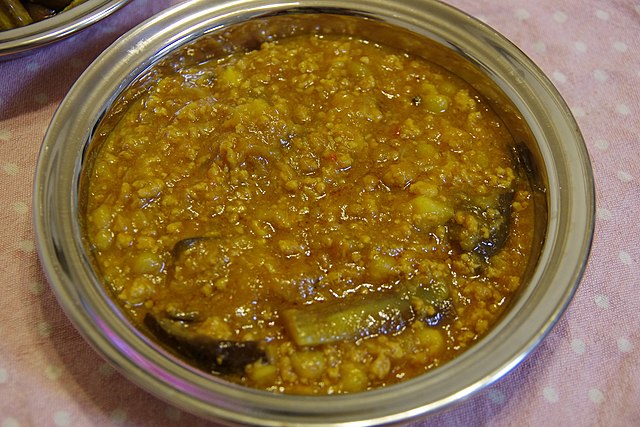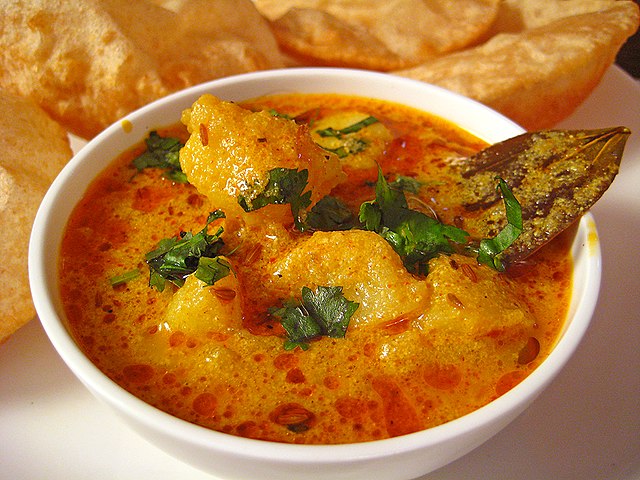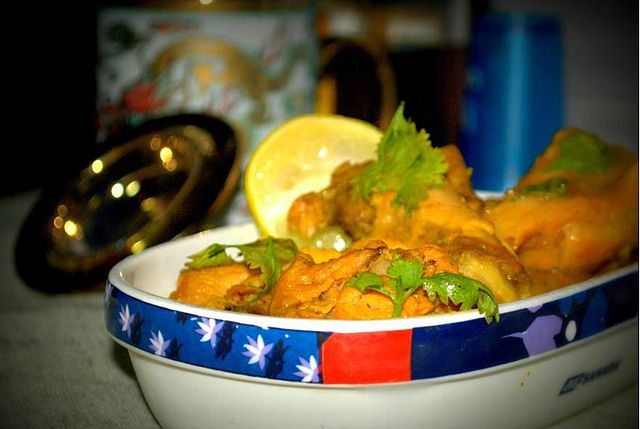Tasty Dishes from the Curry World
By: Habeeb Salloum/Arab America Contributing Writer
Curry, which derives its name from the Indian word kari (sauce), is an Indian condiment par-excellence. Even though it is used to some extent in almost every nation in the world, the countries of the Indian sub-continent along with Myanmar, Thailand, Malaysia, and Indonesia remain its true homeland. The British who ruled most of these countries for some 150 years, today are great curry consumers and even make their own types of curries.
Yet, although most closely associated with the Indian kitchen, every nation or culture has some form of curry, mostly called by other names – such as in the Arab world ras al-hanut, ibzar and baharat – all spice mixtures. Even though they are in numerous cases quite different, they serve the same purpose.
However, those who are enamoured with the true curry need not despair; there are innumerable types of this spice mixture in the curry world. Curries are not uniform in their content and taste and – not only country to country but also in local versions.
Curry can contain over 20 or more spices. On the other hand, many curries contain much less than that number.
One of the most well-known curries familiar worldwide is Garam Masala Curry – a popular northern Indian curry powder. Coming in various mixtures, it is one of the most popular curries used in the Indian sub-continent and beyond. If not available other curries can be used as a substitute.
The bases of the vast majority of curries are chillies – not native to the Indian sub-continent. They were introduced into Asia from the New World by the Portuguese in the 16th century. Strangely the hot food of Asia that we know today did not exist before the discovery of the Americas.
Turmeric is the dominant spice used in all curry mixtures. It gives the curry the yellow color that is the symbol of this spice mixture. Other spices that are commonly included are: cardamom, cinnamon, cloves, coriander, cumin, fennel seed, fenugreek, mace, nutmeg, poppy seeds, red and black peppers, sesame poppy seeds and saffron. Of course, at times other condiments, herbs and spices like curry leaves, garlic, ginger, mustard, paprika and tamarind are added.
Curry powder can be very hot or mild depending on the spices and amounts of each in the mix. Basically, a curry is a spicy recipe, the spiciness differing considerably from country to country. Despite the belief that most curries are very hot, not all are. There are more mild curry recipes than hot ones – some of which cater to highly sophisticated tastes.
For those familiar with the countless Indian curries, those of Sri Lanka are much hotter. The inhabitants of that island are so enamoured with these mixtures of spices that they have developed 17 varieties – three main types: black, red, and white, each imbuing a slightly different subtle taste to food. Curries are served with lunch and dinner and as well, at times, at breakfast. In that country it is said that food and curries are synonymous in the kitchen
Today, as well as in the countries of the Indian sub-continent curry is a key element in Australian, British, Caribbean, South and Southeast Asian and Japanese cooking. While the western palate took longer to ‘discover’ curry’s wonderful taste, it is quite popular in western dishes today and can be seen in many restaurants as an offering in dishes that range from chicken, fish, and meat to vegetables.
As well as making for a tasty meal, curry, due to its combination of many spices, gives the body a powerful health boost. There are a number of health benefits attributed to curry dishes such as reducing inflammation of the joints and easing somewhat the aches of arthritis; while other studies suggest that curries may also help protect us against cancer and heart disease. In Indian Ayurvedic medicine, turmeric, the main ingredient in curries, has been used for untold centuries in treating inflammatory diseases.
However, the benefits of curries are only marginal. The real use of this world-renowned condiment is in the kitchen. Curry powder, into whatever dish it is added, diffuses a piquant and exotic flavour. In India from mother to daughter the inheritance of the world of curry is one of the most important ways of life. Each family usually creates its own family mix which is used in sauces and other dishes. Besides the actual spices the dishes themselves are in many cases simply called ‘Curry’.
This gift of India to the world can be used in casseroles, marinades, sauces, soups, and stews as well as to give a special tang to barbecued meats or vegetables. A little in salads, especially in chicken and potato salads will make for a much talked about party dish. It’s a very versatile spice mixture with its wide range of flavour, having innumerable possibilities in spicing up food.
Mild Curry Powder

If curry is not available, prepare a mixture from these spices. The recipe can be used as a base upon which to make spicier and hotter curries by adding other spices or herbs.
1 tablespoon turmeric powder
1 teaspoon freshly ground cardamom seed
1 teaspoon freshly ground cumin seed
1 teaspoon freshly ground coriander seed
1/2 teaspoon ground cinnamon powder
1/2 teaspoon freshly ground fennel seeds
1/4 teaspoon cayenne
Combine all the ingredients then use or store the resulting curry in an airtight container in a cool place. Curries will lose their colour and aroma when stored for a long period of time and exposed to light. Hence, prepare a small amount at a time.
Chickpea Soup

Serves about 8
A healthy and tasty soup, versions of which are found in the Caribbean, this dish is very simple to prepare.
1 cup dry chickpeas, soaked overnight and drained
8 cups water
2 medium onions, finely chopped
1 small hot pepper, seeded and finely chopped
4 cloves garlic, crushed
4 tablespoons finely chopped coriander (cilantro)
1 1/2 teaspoons salt
1 teaspoon pepper
1 tablespoon curry powder
1 cup 10% cream
Place chickpeas and water in a saucepan and bring to boil, cook over medium heat for 1 hour or until chickpeas are somewhat tender. Add all remaining ingredients, except cream, then cover and cook for a further 45 minutes or until the chickpeas are well cooked, stirring occasionally and adding more water if necessary. Stir in cream then cook for another few minutes.
Purée in a blender then return to saucepan and heat for a few minutes before serving.
Eggplant Curry

Serves about 6
The Indian sub-continent has, perhaps, more varieties of curry dishes, such as this one than the remainder of the world.
1 eggplant, about 1 1/2-pounds, peeled and cut into 8 to 12 slices
1 teaspoon salt
1/2 cup vegetable oil
2 large onions, sliced
2 tablespoons sesame powder
2 tablespoons coconut powder
2 tablespoons tamarind paste dissolved in 1/2 cup water or 2 tablespoons
pomegranate concentrate
1 tablespoon grated fresh ginger
1 medium chilli, seeded and finely chopped
4 cloves garlic, crushed
1 tablespoon curry
1 teaspoon sugar
2 1/2 cups water
4 tablespoons finely chopped coriander (cilantro)
Sprinkle the eggplant slices with the salt, then set aside.
In a saucepan, heat 2 tablespoons of the oil over medium heat then stir-fry onions until lightly browned, adding a little more oil if necessary. Stir in remaining ingredients, except water and coriander, then stir-fry for 2 minutes. Stir in water and boil uncovered over medium-high heat for 10 minutes
In a frying pan, heat the remaining oil, then fry a few of eggplants pieces at a time over medium heat for about 10 minutes or until they begin to soften but still firm, adding more oil if necessary. Remove then drain on paper towels.
Add the fried eggplant to saucepan mixture then reduce heat to medium-low and cook for a further 10 minutes. Garnish with the coriander and serve with plain rice.
Spinach and Lentils Curry

Serves 4 to 6
A fine vegetarian dish, it can be served for lunch, dinner or as a snack.
1/2-pound fresh spinach, thoroughly washed, drained, and chopped into small pieces
3/4 cup split lentils
1 medium onion, finely chopped
2 cloves garlic, crushed
1 large bell pepper, finely chopped
1 tablespoon curry powder
1 teaspoon ground mustard
1 teaspoon salt
3 1/2 cups water
3/4 cup coconut milk
Place all ingredients except coconut milk in a saucepan and bring to boil then cover and cook over medium/low heat for 40 minutes, stirring a few times and adding a little more water if necessary. Stir in coconut milk then cook for a further 5 minutes before serving.
Hot Potato Curry Stew

Serves about 8
I enjoyed a similar dish in a peoples’ eating-place in the United Arab Emirates where Arab taste buds have become accustomed to hot and spicy Indian food.
4 tablespoons olive oil
2 medium bell peppers, seeded and finely chopped
2 medium onions, finely chopped
1/2 cup finely chopped coriander (cilantro)
8 cloves garlic, crushed
1/8 teaspoon cayenne
1 tablespoon curry powder
6 large potatoes (about 2-pounds), peeled and chopped into large pieces
4 cups water
1 1/4 teaspoons salt
1 lemon rind, finely chopped
In a saucepan, heat the oil then sauté pepper and onion over medium heat for 10 minutes. Stir in coriander and garlic then stir-fry for further 3 minutes Add remaining ingredients and bring to boil. Cover and cook over medium heat for 40 minutes or until potatoes are well done, but still somewhat firm, stirring occasionally and adding more water if necessary. Serve hot.
Chicken with Coconut – Poulet au Coco

Serves about 6
Comoros cooks are, as a whole, passionate about their handiwork, especially when they prepare such dishes as Poulet au Coco, a chicken dish cooked with greens and rice, considered one of the most popular dishes in the country.
4 tablespoons butter
2 pounds chicken breast, cut into 1/2-inch cubes
2 medium onions, finely chopped
6 garlic cloves, crushed
2 cups coconut milk
1 cup water
1 tablespoon curry powder
1/4 teaspoon nutmeg
1/2 teaspoon dried thyme
1 cup finely chopped green onions
1 small bunch parsley, finely chopped
1 teaspoon salt
1/2 teaspoon black pepper
3 cups cooked rice
1 fresh lime
In a saucepan, melt the butter then fry chicken over medium heat for 10 minutes or until golden. Stir in the onions, garlic, coconut milk, water, curry, nutmeg, and thyme then bring to boil. Cover and cook the mixture over medium heat for 10 minutes, occasionally stirring, then add the green onions, parsley, salt, and pepper. Stir well and allow to cook over medium heat for 30 minutes, stirring occasionally and adding a little water if necessary.
Evenly place rice on a serving platter then spread chicken with its sauce over top. Squeeze lime juice over the top and serve.
Curried Fish

Serves 4 to 6
It is apparent that this Kuwaiti dish came to Kuwait from the Indian sub-continent, either with the Kuwaiti Indian and Arab traders or with the thousands of workers lured to the Arab Gulf states by the petroleum industry.
1/2 cup cooking oil
1 large onion, sliced
1/2 head of garlic, chopped
1 small hot pepper, seeded and thinly sliced
1 teaspoon grated fresh ginger
4 tablespoons tomato paste
2 medium tomatoes, diced into 1/2-inch cubes
1/2 teaspoon salt
2 teaspoons curry powder
1 cup water
2-pounds fish fillet, cut into serving pieces
In a large frying pan, heat the oil then add onion, garlic, hot pepper and ginger and sauté over medium heat until onion is golden. Stir in tomato paste and fresh tomatoes then simmer over medium-low heat for 5 minutes. Stir in the salt, curry and water then cover and simmer over medium-low heat for 20 minutes, stirring occasionally. Add fish fillet then re-cover and simmer over low heat for 25 minutes or until fish is done. Serve with cooked rice.


